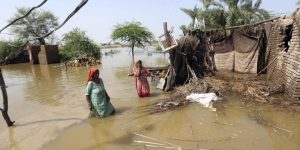It is when a natural disaster hits a country that its government, international humanitarian agencies, and the media wake up to the vulnerability of the people, especially those living in extreme poverty. This is the case in Pakistan.
In the summer of 2022, Pakistan was hit by unprecedented rains. A third of the country was under flood water; more than 2,000 people lost their lives and millions of others lost their homes and livelihoods. Most of the displaced are still living in temporary camps and struggling to make ends meet.
Long before the disaster, Pakistan struggled with visible poverty and disparity. There was always a gap in the living conditions of people in the country’s towns and cities and those in rural areas. The 2022 floods laid bare to the world the ravages of climate change and its effects. But also it underscored the negligence, lack of effective policy, broken infrastructure, regional inequalities, and above all extreme poverty that determined the magnitude of the devastation.
According to the 2019-2020 Pakistan Social and Living Standards Measurement Survey (PSLM), 37.8 percent of Pakistan’s population lives in multidimensional poverty. Although the proportion of Pakistan’s population living in poverty has been falling over the years – it is said to have halved over the past two decades – it is expected to rise as a result of the 2022 floods. The Post-Disaster Needs Assessment (PDNA) has predicted that the proportion of the population living in poverty is now likely to increase to 43.7 percent.
Natural disasters may be unavoidable, but much of the loss and devastation they leave behind could be prevented through better planning, infrastructure and poverty reduction initiatives.
One such initiative is the Ministry of Planning’s five-year development plan for 2022-2027 for 20 of the poorest districts of Pakistan, many of which were severely affected by the floods. These districts were carefully chosen through the government of Pakistan and the UNDP’s multidimensional poverty index (MPI) survey.
Among these 20 districts, 11 are in Balochistan, Pakistan’s most impoverished province, which has been wracked by armed conflict for more than two decades now. Five districts are in Sindh, three are in Khyber Pakhtunkhwa (bordering Afghanistan and under the intermittent control of the Tehreek-e-Taliban Pakistan militant group), and one district is in Punjab, the largest of the 20 in terms of population.
According to the Ministry of Planning, the initiative is specially designed for the socioeconomic upliftment of the backward districts, to reduce regional disparities and strengthen national integration as a result, promote inclusive and equitable development, and attract investment in infrastructure and human development.
To achieve these objectives, the tentative interventions envisaged so far by the government include improving physical connectivity through roads and highways; power and digital connectivity through internet and solar power installations; livelihood initiatives relating to farming, border markets, and industrial setups; and social development and protection through education, health, and access to skill development and scholarship programs.
It is believed that with these interventions and proper planning, the districts can be made more livable and disaster-resilient, and the ongoing internal migration of the poor from rural areas to urban slums can be controlled to an extent.
Achieving the goals in a span of five years seems ambitious. The Planning Commission has not shared how it intends to implement the plan.
However, Federal Minister for Planning and Development Ahsan Iqbal recently tweeted that the government is considering drawing on the suggestions of local communities, provincial and national representatives from the selected districts, and experts to make the initiative more effective and achievable.
The first phase of the project is estimated to cost around $207 million, which will be shared equally between the federal and provincial governments.
The question is how is the government going to fund the ambitious poverty eradication plan. Pakistan is going through one of its worst economic crises ever, one that has been worsened by the floods last year that caused estimated damages of more than $30 billion.
In early February, inflation rose to a 48-year high, making it harder for the poor to afford basic food items. Meanwhile, the IMF has laid down conditions that Pakistan will have to meet to access the loan package. These conditions include the imposition of higher taxes on the rich for greater revenue generation. But experts believe raising taxes even for the rich can have implications for the economy.
The government’s initiative is important. However, it is doubtful whether it can succeed given Pakistan’s structural economic problems, poor management of public funds, widespread corruption, and a foreign policy that supports overreliance on external financial assistance. Will the federal and provincial governments be able to eradicate poverty from the 20 districts? Or will they push the chosen districts deeper into poverty?

































